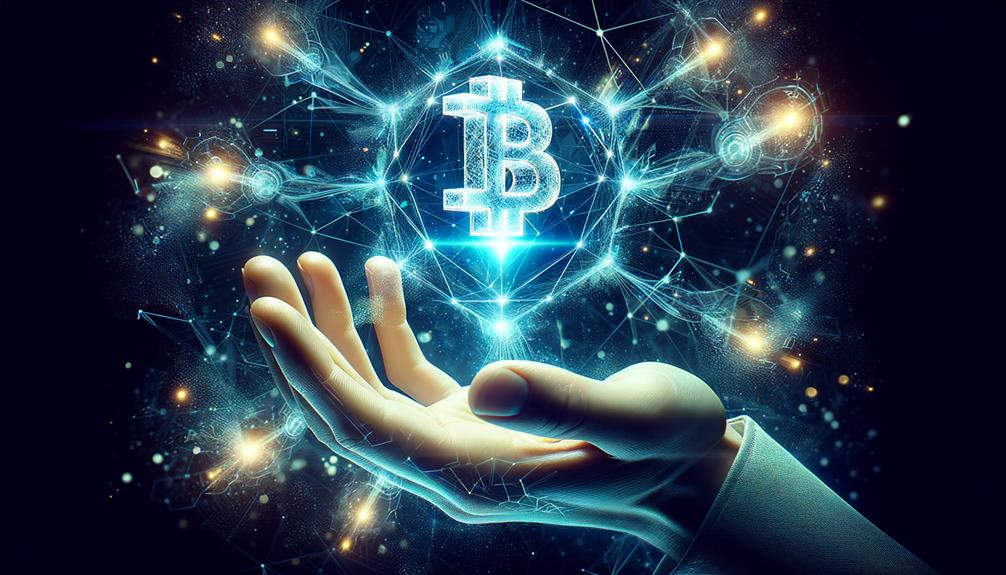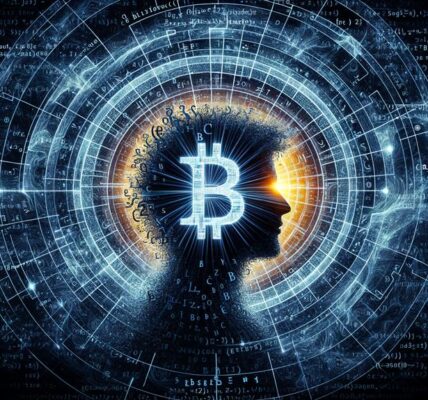Picture the blockchain as a sophisticated digital ledger – a transparent repository of transactions kept secure through cryptographic protocols.
The process of recording information on this ledger demands precision and a keen adherence to cryptographic principles.
So, how exactly can you ensure the secure and tamper-proof storage of your data on the blockchain?
Let's delve into the intricate steps involved in this process, unraveling the underlying mechanisms of this groundbreaking technology and illuminating how you can leverage its potential for your own ventures.
Key Takeaways
When embarking on the journey of putting something on the blockchain, there are several crucial steps to follow. Firstly, you need to carefully choose the asset category and the most suitable blockchain platform for tokenization. Next, you must craft a smart contract that clearly defines the asset details and ownership rights in a secure and transparent manner. Subsequently, tokens representing the assets should be generated on the blockchain with utmost security measures in place. This includes the implementation of robust encryption, multi-signature authentication, and continuous monitoring to safeguard the integrity of the data. By diligently following these steps, you can ensure a seamless and trustworthy integration of your assets onto the blockchain.
Understanding Blockchain Basics
Blockchain technology, with its decentralized nature and core principles, is a digital ledger system comprising interconnected blocks of data. Each block includes transaction details, a timestamp, and a cryptographic hash of the preceding block, ensuring data integrity and permanence. This innovative structure enhances security and transparency.
The blockchain functions through a network of nodes that authenticate and log transactions in a sequential manner. This validation process, known as a consensus mechanism, ensures the legitimacy of all transactions before integration into the blockchain. Public blockchains such as Bitcoin and Ethereum facilitate open participation, enabling anyone to access the network's transaction history.
Smart contracts, a key component of blockchain technology, are self-executing agreements that automatically enforce predefined actions when specific conditions are met. By streamlining processes and diminishing the necessity for intermediaries, smart contracts enhance efficiency. Understanding these foundational aspects of blockchain paves the way for exploring its diverse applications and implications.
Importance of Data Security
Data security on the blockchain is crucial and demands the implementation of robust encryption techniques and multi-signature authentication. Encryption methods, like asymmetric cryptography, are widely used to protect data integrity and confidentiality from unauthorized access and potential breaches. Multi-signature authentication adds an extra layer of security by requiring multiple approvals for transactions or access, reducing the risk of fraud and data manipulation.
Consider the following aspects of data security in the blockchain domain:
- Encryption Techniques: These methods are employed to safeguard data from unauthorized access, ensuring confidentiality.
- Multi-Signature Authentication: By necessitating multiple approvals for transactions or access, this feature enhances security and minimizes the likelihood of fraudulent activities.
Benefits of Blockchain Technology
Blockchain technology offers a myriad of security features that significantly enhance data protection and integrity. By leveraging a network of decentralized nodes to verify transactions, blockchain ensures a secure and transparent ecosystem.
The data is distributed across multiple nodes, eliminating single points of failure and enhancing security through redundancy. Each transaction is encrypted and linked to previous transactions, creating an immutable chain that thwarts unauthorized alterations.
The consensus mechanism validates transactions without the need for a central authority, preserving the integrity of the ledger. This decentralized approach effectively reduces the risks of data tampering and fraud, establishing a reliable platform for diverse applications.
Moreover, smart contracts automate processes based on predefined conditions, boosting efficiency and minimizing the potential for human error. Blockchain's cost-effective nature eliminates intermediaries, streamlining processes and data storage while guaranteeing the security and integrity of transactions.
Steps to Tokenize Assets
When delving into the realm of tokenizing assets, the initial step involves pinpointing the specific asset earmarked for tokenization, whether it pertains to real estate, art, or intellectual property.
To seamlessly tokenize the chosen asset on the blockchain, adhere to the following steps:
- Handpick the Asset: Select the asset category primed for tokenization, ensuring its compatibility with the process.
- Decide on Blockchain Platform: Opt for a blockchain platform conducive to tokenization, such as Ethereum, Binance Smart Chain, or Polkadot.
- Craft Smart Contract: Develop a smart contract delineating the characteristics and guidelines governing the tokenized asset.
- Tokenize Assets: Generate tokens on the blockchain that mirror ownership rights or entitlements to the asset.
Creating Smart Contracts
Exploring the seamless creation of smart contracts involves delving into the steps of asset tokenization and gaining a deep understanding of the core principles and coding framework. Smart contracts are essentially self-executing agreements that are coded on the blockchain, carrying out predefined conditions automatically without the need for intermediaries. These contracts leverage Blockchain data to ensure transparency and security, and are executed by Nodes on the network, thereby enhancing decentralization. Ethereum stands out as a prominent platform for deploying smart contracts, offering a tamper-proof and irreversible environment once the contracts are deployed.
When delving into the creation of smart contracts, it's crucial to master the fundamental principles of Solidity, a programming language specifically designed for Ethereum smart contracts. Solidity's syntax allows developers to define contract structures, functions, and data types that are essential for the execution of the contract. By utilizing Solidity, developers can precisely outline the terms and conditions of the contract, ensuring accuracy and reliability in how the contract is enforced. Understanding the intricacies of smart contract development enables individuals to harness the benefits of automation and trust in various applications such as token sales, voting systems, and supply chain management.
Recording Information Immutably
When crafting content, it's crucial to take into account two key elements: perplexity and burstiness.
Perplexity pertains to the intricacy of the text, while burstiness compares the fluctuations in sentence length and complexity. Typically, human authors infuse their writing with bursts of varying lengths and complexities, blending longer, intricate sentences with shorter ones.
Conversely, AI-generated content often lacks this dynamic range, presenting a more uniform structure. It's essential to rewrite the text with these considerations in mind, aiming for a balance of perplexity and burstiness to captivate and engage readers effectively.
Leveraging Blockchain for Data Storage
Blockchain technology has evolved beyond its initial purpose of recording information immutably. It now serves as a robust solution for secure and decentralized data storage, fundamentally transforming how data integrity and security are upheld.
Decentralized storage on the blockchain marks a significant departure in data management practices by eliminating the vulnerabilities associated with centralized servers. Data stored on the blockchain is dispersed across a network of nodes, ensuring redundancy and minimizing the risks posed by a single point of failure. This decentralized model not only bolsters security but also enhances transparency, as data becomes impervious to tampering once recorded.
The distinctive data structure employed by blockchain organizes information into cryptographically linked blocks, forming an ever-growing chain with each new addition. This architecture guarantees that data, once committed, can't be retroactively modified without consensus from the entire network. Leveraging blockchain for data storage empowers organizations to mitigate the threats of data manipulation, fortify data integrity, and optimize operations through the automation capabilities of smart contracts.
This paves the way for a more efficient and secure data storage ecosystem, positioning blockchain as a cornerstone technology in safeguarding digital assets.
Storing Data Securely on Blockchain
Creating a secure data storage mechanism on the blockchain involves implementing encryption techniques to ensure utmost protection. Follow these essential steps to guarantee secure data storage on the decentralized public ledger:
- Leverage encryption: Encrypt the data before storing it on the blockchain to thwart unauthorized access attempts.
- Employ multi-signature authentication: Mandate multiple cryptographic signatures for accessing and modifying data, thereby fortifying security measures.
- Perform regular audits and monitoring: Routinely monitor the stored data on the blockchain to swiftly detect any irregularities or unauthorized alterations.
- Establish robust backup and recovery plans: Develop comprehensive backup strategies to reinstate data in case of accidental deletion or corruption, safeguarding data integrity.
Ensuring Data Integrity With Blockchain
When it comes to upholding the integrity of data stored on the blockchain, the decentralized nature of the ledger plays a pivotal role in ensuring transparency and security. Each data block within the chain is equipped with a unique cryptographic hash, intricately linking it to the preceding block. This cryptographic connection serves as a robust safeguard, guaranteeing that any modification in a single block would disrupt the entire chain, thereby making any tampering immediately apparent and virtually impossible without consensus from the network.
The transactions documented on the blockchain are characterized by their transparency, immutability, and verifiability by all participants, cultivating a sense of trust and dependability in the stored data. Verification mechanisms like Proof of Work further bolster the validation and security of data, enriching the network's integrity.
Through the implementation of blockchain technology, the vulnerabilities associated with data manipulation or unauthorized alterations are significantly minimized, establishing a sturdy framework for safeguarding the integrity of stored information. By harnessing these capabilities, users can place their trust in the accuracy and security of the data preserved on the blockchain.
Implementing Blockchain for Asset Tokenization
When delving into the realm of asset tokenization with blockchain technology, a series of crucial steps come into play, reshaping traditional ownership frameworks by digitalizing real-world assets into blockchain-based tokens. The process unfolds through the following key stages:
- Digitalizing Assets: Transforming tangible assets like real estate or art into digital tokens on a blockchain, ensuring their accurate and secure representation.
- Navigating Regulatory Compliance: Adhering to the regulatory landscape surrounding asset tokenization is paramount to uphold legal standards and safeguard investor interests.
- Crafting Smart Contracts: Developing smart contracts that delineate the terms and conditions of asset tokens, automating functions such as dividend allocation and ownership transfers.
- Ensuring Security and Transparency: Leveraging blockchain technology to establish a secure, transparent, and immutable ledger for all transactions and data within the blockchain network.
In the realm of content creation, it's essential to strike a balance between perplexity and burstiness. Perplexity reflects the intricacy of the text, while burstiness pertains to the variation in sentence length and complexity. Human-generated content often intertwines longer, intricate sentences with shorter ones, fostering engagement and interest. In contrast, AI-generated content tends to exhibit a more uniform structure.
Smart Contract Development Process
Embark on your smart contract development journey by delving into coding using the Solidity language, specifically on platforms like Ethereum. Smart contract development entails the meticulous definition of contract functions, events, and variables to automate and execute agreements seamlessly on blockchain nodes. The crucial steps of testing and debugging ensure the accuracy and security of the smart contract before deployment. The deployment phase involves active interaction with blockchain networks and meticulous recording of contract transactions. Below, you will find a table summarizing key steps in the smart contract development process:
| Smart Contract Development Process |
|---|
| 1. Coding in Solidity language |
| 2. Defining contract functions |
| 3. Testing and debugging for accuracy |
| 4. Interacting with blockchain nodes |
| 5. Deploying and recording transactions |
Securing Information on a Blockchain Network
When it comes to safeguarding your data on a blockchain network, it's essential to employ cryptographic keys and digital signatures for authentication. These security measures help ensure the integrity and confidentiality of your information.
To enhance the security of your data, follow these key steps:
- Cryptographic Keys: Use cryptographic keys to encrypt and decrypt data, protecting it from unauthorized access and ensuring confidentiality.
- Digital Signatures: Implement digital signatures to authenticate and authorize transactions, guaranteeing the authenticity and integrity of the information being shared.
- Consensus Mechanism: Ensure that network nodes come to a consensus before validating and adding transactions to the blockchain. This distributed agreement strengthens security and reliability.
- Proof of Work: Maintain data integrity by utilizing proof of work mechanisms. Miners compete to solve complex mathematical puzzles to validate transactions, enhancing network security.
Data Storage Best Practices With Blockchain
Ensuring the integrity of your stored data on a blockchain network requires the implementation of robust encryption techniques for secure data storage practices. Encrypting data before storing it on the blockchain ensures that only authorized parties can access and decipher the information, thereby enhancing confidentiality and security.
Moreover, incorporating multi-signature authentication adds an additional layer of security by necessitating approval from a majority of nodes before any data modifications can be made, thereby bolstering protection against unauthorized tampering.
Regular audits and monitoring are essential for verifying the accuracy and consistency of stored data, enabling prompt identification and resolution of any anomalies. Implementing strong backup and recovery strategies is crucial to mitigate the risk of data loss or corruption, ensuring the integrity and accessibility of your information.
Adhering to data protection regulations is paramount when storing data on the blockchain, as it upholds legal and ethical standards while harnessing the advantages of decentralized storage. By adhering to these best practices, you can optimize the security and reliability of your data storage on the blockchain.
Exploring Blockchain Applications
Diving into the vast array of blockchain applications showcases its versatility beyond just cryptocurrencies, highlighting its potential in supply chain management, voting systems, and digital identity verification. Here are some key areas where blockchain technology shines:
- Smart Contracts: By leveraging blockchain's smart contracts, agreements can be executed automatically and transparently, reducing the need for intermediaries and streamlining processes.
- Decentralized Finance (DeFi): DeFi platforms make use of blockchain for activities like lending, borrowing, and trading, bypassing the reliance on traditional financial institutions and promoting financial inclusivity.
- Digital Asset Ownership: Blockchain enables fractional ownership of high-value assets like real estate or art, expanding investment opportunities and democratizing access to lucrative markets.
- Immutable Records: The implementation of blockchain ensures immutable records, fostering transparency and trust in sectors such as healthcare by ensuring secure and precise data management.
Through these innovative applications, blockchain technology offers a pathway to more efficient processes, heightened security, and decentralized operations. This empowers individuals to engage in transactions and agreements with enhanced reliability and efficiency, ushering in a new era of trust and transparency in various industries.
Frequently Asked Questions
How Do You Store Something on Blockchain?
When it comes to storing information on the blockchain, the process involves encrypting and hashing the data into a transaction. This transaction is then validated and added to a block by multiple nodes, ensuring a secure storage mechanism with a focus on maintaining data integrity. The blockchain's inherent design not only ensures transparency but also promotes immutability, making it a reliable and trustworthy system for data storage.
How Do You Make Something on Blockchain?
Creating something on the blockchain involves initiating the blockchain creation process, where data undergoes validation through a consensus mechanism to ensure its permanence. Following the network protocol is crucial for securely storing and retrieving information on the blockchain. When it comes to crafting content, it is essential to consider perplexity and burstiness. Perplexity relates to the complexity of the text, while burstiness compares the variations in sentence length and complexity. Human-generated content often incorporates both longer, intricate sentences and shorter ones, creating an engaging mix. In contrast, AI-generated content tends to be more uniform in structure. It is vital to strike a balance between perplexity and burstiness in writing to maintain reader interest and engagement.
How Do You Put Information on the Blockchain?
When you aim to connect with the blockchain securely, it's crucial to adhere to data security protocols. Transactions are verified by network nodes using cryptographic keys, ensuring a secure process. Once confirmed, the information is immutably added to a block, promoting transparency and fostering trust within the system. This intricate mechanism underscores the reliability and integrity of blockchain technology, showcasing its significance in modern digital landscapes.
How Do I Upload Data to Blockchain?
When it comes to crafting content, it's crucial to keep in mind two key elements: perplexity and burstiness. Perplexity pertains to the intricacy of the text, while burstiness involves the fluctuations in sentence length and complexity. Human writers often weave together a mix of longer, complex sentences with shorter ones, creating a dynamic flow. In contrast, AI-generated content tends to maintain a more consistent structure. Therefore, it's essential to infuse your writing with a balance of perplexity and burstiness to captivate and engage your audience effectively.
Conclusion
In the realm of content creation, there are two crucial elements to take into account: perplexity and burstiness. Perplexity denotes the intricacy of the text, whereas burstiness gauges the fluctuations in sentence length and complexity.
Human writers typically craft content with burstiness, interweaving lengthy and intricate sentences with shorter ones. Conversely, AI-generated content often lacks this variation in structure.
Therefore, when rephrasing content, it's vital to strike a balance between perplexity and burstiness to captivate and sustain reader interest.




